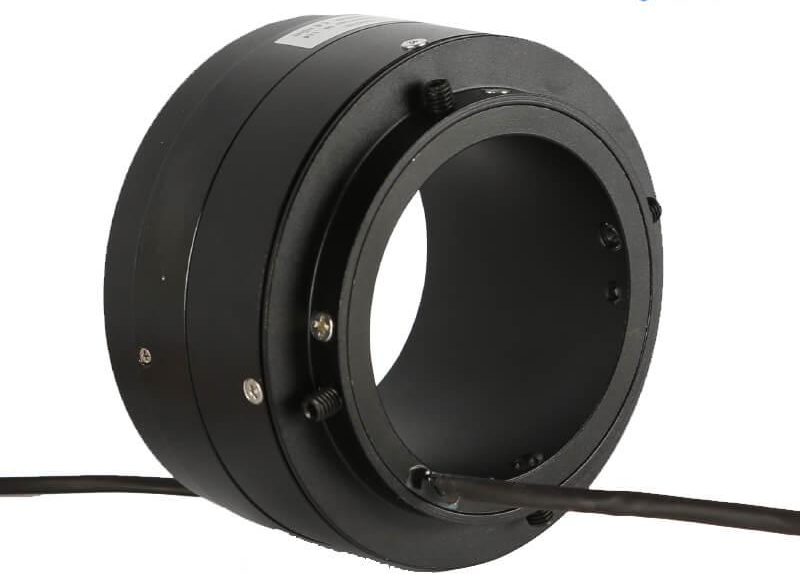Introduction
In the world of rotating equipment, slip rings play an indispensable role. They provide a continuous and stable passage through which signals and power can be transmitted between stationary and rotating structures. As a critical component of these devices, Slip Ring IDs determine the compatibility and operational efficiency of installations. While many people understand the importance of the slip ring itself, Slip Ring ID is an attribute that may not receive the attention it deserves. In this article, we’d like to draw focus on this essential component, offering insights into its various uses, and selection strategies, and answering common questions that surround it. By understanding the importance of Slip Ring ID and its relationship with its application, we aim to provide a comprehensive guide for those using slip rings across an array of industries.
What Are Slip Ring IDs?
The ID in Slip Ring ID stands for Inner Diameter. It refers to the internal section or gap in a slip ring through which the shaft or mount passes. This Inner Diameter measurement is crucial for both the mechanical installation process and the proper functioning of a slip ring assembly. The compatibility of a slip ring’s ID with the diameter of the shaft or mounting structure determines the stability, strength, and performance of the overall system in terms of speed, torque, and power transmission efficiency.
These dimensions vary for different types of slip rings based on their application, design, and specific requirements. Each slip ring’s ID carries inherent importance as it affects critical aspects like signal quality, contact resistance, electrical wear, and temperature rise. To optimize the workability and efficiency of a rotating system, it is necessary to understand the role of Slip Ring IDs and ensure compatible integration during installation.
How to Choose the Appropriate Slip Ring ID?
Choosing the right Slip Ring ID is crucial for ensuring compatibility, smooth rotation, and optimal performance of the rotating system. There are several factors to consider when selecting an appropriate Slip Ring ID:
The shaft or Mounting Structure Diameter
The first primary consideration is the diameter of the shaft or the mounting structure on which the slip ring will be installed. The Slip Ring ID must be greater than the diameter of the shaft or mount to ensure a seamless fit. Usually, you should allow for some tolerance between the Slip Ring ID and the shaft diameter, as close alignment ensures smooth rotation without causing undue friction or instability.
Operating Conditions
Operating conditions such as speed, torque, temperature, and environmental factors have a direct impact on the suitable Slip Ring ID. For instance, higher-speed operations might require larger IDs, which can withstand the associated stresses and temperature rise. On the other hand, compact equipment with limited space might necessitate a smaller ID. Take into account the specific requirements of your application to determine the ideal Slip Ring ID.
Slip Ring Materials and Design
The material composition and design of the slip ring can affect the ID selection. For example, certain materials might perform better under specific circumstances (e.g., thermal conductivity, wear resistance, etc.). Slip rings made from materials with excellent conductivity or wear resistance might offer better performance with a smaller ID. The design of the slip ring, such as capsule, pancake, or through-hole, should also be considered, as each design requires different ID specifications.
Long-term Reliability and Maintenance
While selecting a Slip Ring ID, it’s crucial to keep in mind long-term reliability and maintenance requirements. Slip rings with a smaller ID might require more frequent maintenance due to the increased contact resistance and wear. Thus, it’s essential to strike a balance between installation requirements and long-term performance.
By carefully considering these factors, you’ll be better equipped to choose an appropriate Slip Ring ID that will ensure compatibility with the rotating system and deliver optimal performance in the long run.
Application of Slip Ring ID with Different Values
The significance of the Slip Ring ID is evident when considering its specific applications in different sectors. These IDs play a key role in defining the scope and functionality of the device in which the slip ring is installed.
Electric Motors
Your typical electric motor demands both high-speed rotation and a hefty load-carrying capacity. To handle this, slip rings with larger IDs are utilized. These larger IDs accommodate sturdy shafts, allowing for higher RPMs and better load endurance while ensuring stable electrical lifting.
Miniature Devices
Miniature devices or compact electrical systems, such as endoscopes and drones, require smaller, lightweight slip rings. The smaller ID slip rings used in these systems facilitate the space-saving design and delicate rotation needs.
Wind Turbines

Wind turbines are another great example of slip rings with large IDs in application. Given the high-speed revolutions and constant voltage requirements of these turbines, they use slip rings with large IDs to accommodate substantial rotating shafts. This helps guarantee uninterrupted power or signal transmission, ensuring that the wind turbine functions efficiently and without breaks in power.
Robotic Systems

In robotic systems, where precision and consistency are paramount, the role of Slip Ring ID becomes highly essential. Both small and large ID slip rings can be used, depending on the size of the robotic device and the requirement of precision in rotational movements.
Military and Aerospace Equipment

In military and aerospace equipment, slip rings are subjected to extreme environments and additional safety requirements. Slip Ring ID is chosen considering the environment, the size and weight restrictions, and the need for reliable, uninterrupted signal and power transmission.
In summary, Slip Ring ID’s impact is quite significant across various industries. Their values dictate the usability and efficiency of the equipment they’re built into, influencing critical factors like signal integrity, rotational speed, and system stability. Depending on the specific needs of a rotating system, Slip Ring IDs of different sizes can vastly alter the performance of the equipment. Hence, understanding their impacts becomes ever more crucial for effective system operation.
Slip Ring ID and Slip Ring Unsmooth Rotation
One of the potential issues caused by an improperly selected Slip Ring ID is unsmooth rotation, which may adversely affect the machine’s functionality and wear rate. An unsmooth rotation can be the result of several factors related to the Slip Ring ID:
Tight Slip Ring ID
If the Slip Ring ID is too tight, it may create unwanted friction between the slip ring and the shaft or mount, leading to increased wear and a decrease in the rotational speed. This friction generates heat, which can further exacerbate the wear on both the slip ring and the shaft, and potentially affect the signal and power transmission accuracy.
Loose Slip Ring ID
Conversely, if the Slip Ring ID is too large compared to the shaft diameter, there might be insufficient contact between the slip ring and the shaft, causing instability and vibration during rotation. This unstable connection may result in intermittent electrical contacts, leading to fluctuations or disruptions in power transmission and even leading to eventual system failure.
Misaligned Slip Ring ID
Misaligned Slip Ring ID is another factor that contributes to unsmooth rotation. An uneven gap between the slip ring and the shaft may cause inconsistent contact, leading to variable resistance, temperature rise, and wear on the brushes and slip ring surface. This, in turn, influences the rotational stability and signal consistency.
Deformation or Dirt Accumulation
An improperly chosen Slip Ring ID can cause deformation or issue with dirt accumulation, leading to unsmooth rotation. For instance, a larger than required Slip Ring ID can allow for dirt accumulation or dust ingress, which may influence the slip ring’s performance and rotational stability. Additionally, excessive forces on a tight Slip Ring ID may lead to deformation of the slip ring, further exacerbating the unsmooth rotation issue.
To avoid unsmooth rotation and its adverse effects on system performance, it is crucial to select an appropriate Slip Ring ID that carefully balances the needs of the specific application, including the shaft diameter, allowance for proper contact, and environmental factors. Selecting a Slip Ring ID that is the best fit for your system will ensure smoother motion, reduce wear, and increase equipment efficiency and lifespan.
Slip Ring ID Data of Different Types of Slip Rings
Each different type of slip ring comes with a different set of Slip Ring ID data. For instance, capsule slip rings often have smaller IDs compared to pancake or through-hole slip rings. This data is essential for determining which slip ring can correctly fit the user’s application.
Through Hole Slip Ring
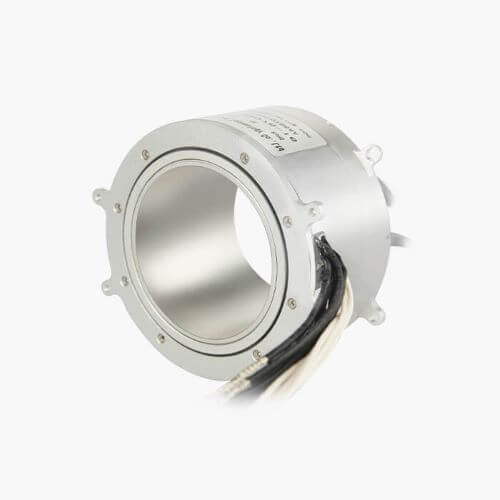
Through hole slip ring is a kind of slip ring with a hole in the center. Same meaning as a through-bar slip ring, sometimes called a hollow shaft slip ring. Through hole slip ring totally meets with continuous transmission of power, signals, weak current, high current, and high voltage under 360-degree unrestrained rotations. Low torque, low electrical noise, low loss, and easy maintenance as the main features.
The process of manufacturing and principle are similar to other slip rings. Power, signals, and other data are transmitted from the fixed position to the rotating position through the contact between the brush and the contact. Gold brush and contact will increase the working life. The basic technical parameters of a hole/bore slip ring mainly include bore outer diameter, bore inner diameter, length, circuits, voltage, current, maximum speed, etc. The length is variable and can be customized arbitrarily, while the outer diameter and inner diameter have some standard dimensions in through hole electrical slip rings industry. The number of circuits is the one core parameter for this series of products, the larger the number of circuits, the more complex the manufacturing process, and the higher the price cost.
Model | Picture | No. of Rings | ID(mm) | OD(mm) | Rated Current | Rated Voltage | |
1-12 | 12 | 33 | 2A | 0~240V | |||
1-24 | 12 | 54 | 5A | 0~240V | |||
1-10 | 20 | 60 | 2A~10A | 0~380V | |||
1-48 | 25.4 | 78 | 2A~10A | 0~380V | |||
1-48 | 38.1 | 99 | 2A~15A | 0~380V | |||
1-10 | 50 | 75 | 2A~12A | 0~380V | |||
1-72 | 50 | 120 | 5A~20A | 0~380V | |||
1-96 | 60 | 135 | 5A~20A | 0~380V | |||
1-96 | 70 | 155 | 5A~20A | 0~380V | |||
1-96 | 80 | 180 | 5A~20A | 0~380V | |||
1-96 | 90 | 190 | 5A~20A | 0~380V | |||
1-96 | 100 | 203 | 5A~20A | 0~380V | |||
1-96 | 120 | 250 | 5A~20A | 0~380V | |||
1-96 | 150 | 300 | 5A~20A | 0~380V | |||
1-96 | 180 | 332 | 5A~20A | 0~380V | |||
1-96 | 200 | 350 | 5A~20A | 0~380V | |||
1-96 | 250 | 407 | 5A~20A | 0~380V | |||
1-96 | 300 | 490 | 5A~20A | 0~380V | |||
1-96 | 400 | 632 | 5A~20A | 0~380V |
Ethernet Slip Ring
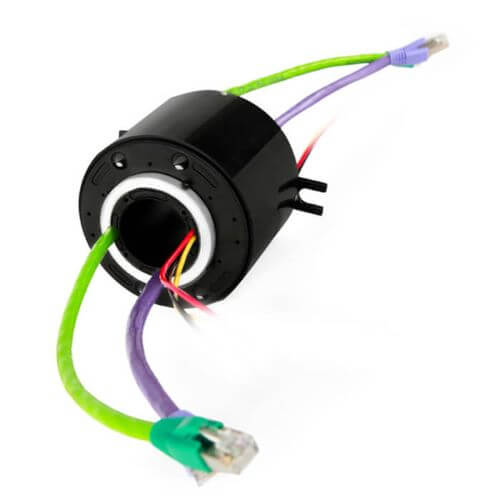
Ethernet slip rings are slip rings with Ethernet connectors that allow to transmission of Ethernet protocol through a rotating interface. Ethernet hybrid slip rings run power, signal, and Ethernet from stationary structures to rotating platforms through copper or gold channels. Can mix electrical power and signals, and also transmit multi-channel low-frequency signals and currents.
Ethernet slip ring suitable for 10/100/1000 Base T transmission and usually equipped with RJ45 connector assemblies for plug and play. M12, CAT5E, or CAT6 cables are available as options. Gigabit ethernet slip rings can be used in wind turbines, industrial robots, and radar antennae which need rotary platforms.
Pancake Slip Ring

The pancake slip ring is similar to through through-hole slip ring but is especially used for the rotating system with a height limit. Also called flat slip ring, flat disc electrical slip ring, or platter slip ring, since the shape is similar to a platter, rings, and brushes contact around the center of the circle. Pancake slip ring components include stator, rotor, and contacts, mainly used for transmitting precise signals and power or combined with pneumatic and hydraulic media. More electrical power, current, and signal circuits can extend broadwise limitless on flat diameter.
Pancake slip rings can be configured in two types, integrated and separated.
Integrated ring types can be designed for solid or through-hole rotating systems.
The separated ring type is composed of a separated rotor and contact brush, which can be designed with PCB.
High Temperature Slip Ring
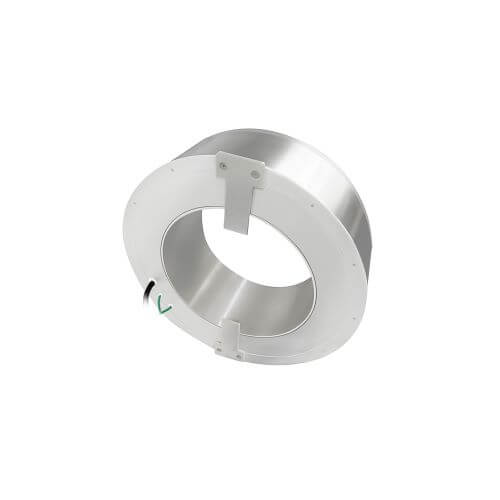
The slip ring can work stably under a 100~250℃ high-temperature environment, even above 250℃.
Model | No. of Rings | ID(mm) | OD(mm) | Rated Current | Rated Voltage | |
1-12 | 12.0 | 33.0 | 2A | 0~240V | ||
1-24 | 12.7 | 54.0 | 5A | 0~240V | ||
1-10 | 20.0 | 60.0 | 2A~10A | 0~380V | ||
1-48 | 25.4 | 78.0 | 2A~10A | 0~380V | ||
1-48 | 38.1 | 99.0 | 2A~15A | 0~380V | ||
1-72 | 50.0 | 120.0 | 5A~20A | 0~380V | ||
1-96 | 60.0 | 135.0 | 5A~20A | 0~380V | ||
1-96 | 70.0 | 155.0 | 5A~20A | 0~380V | ||
1-96 | 80.0 | 180.0 | 5A~20A | 0~380V | ||
1-96 | 90.0 | 190.0 | 5A~20A | 0~380V | ||
1-96 | 100.0 | 203.0 | 5A~20A | 0~380V | ||
1-96 | 120.0 | 250.0 | 5A~20A | 0~380V | ||
1-96 | 150.0 | 300.0 | 5A~20A | 0~380V | ||
1-96 | 180.0 | 332.0 | 5A~20A | 0~380V | ||
1-96 | 200.0 | 350.0 | 5A~20A | 0~380V | ||
1-96 | 250.0 | 407.0 | 5A~20A | 0~380V | ||
1-96 | 300.0 | 490.0 | 5A~20A | 0~380V | ||
1-96 | 400.0 | 632.0 | 5A~20A | 0~380V |
USB Slip Ring
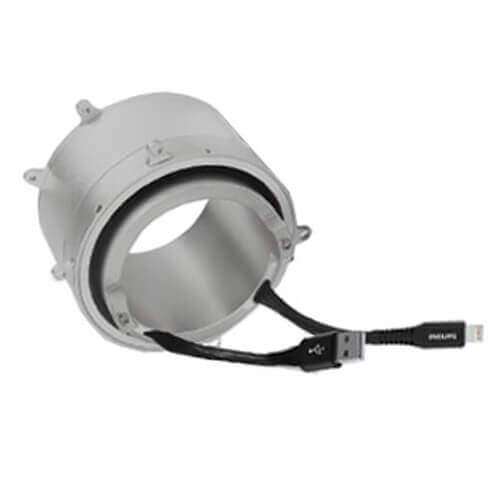
A USB slip ring is specially designed to transmit USB1.0/USB2.0/USB3.0 signals through a rotating interface. USB 2.0 slip rings are widely used in all kinds of communication systems since the USB interface is very popular and convenient for HD video and super-large storage devices. The new generation slip ring for standard USB 3.0 provides a theoretical transmission rate of 5Gbps.
High Speed Slip Ring
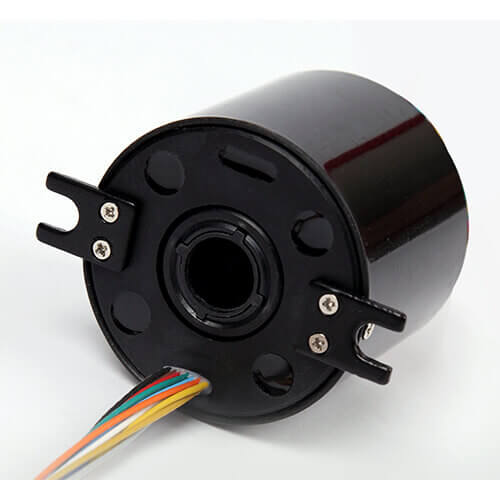
A slip ring can reach 2000 rpm and work stable, even above 4000 rpm.
Model | No. of Rings | ID(mm) | OD(mm) | Max Speed | |
3 | -- | 12 | 800 rpm | ||
10 | 8 | 54 | 2000 rpm | ||
10 | 20 | 78 | 2000 rpm | ||
10 | 35 | 99 | 2000 rpm | ||
10 | 45 | 120 | 2000 rpm | ||
10 | 55 | 135 | 2000 rpm | ||
18 | -- | 30 | 2000 rpm | ||
36 | -- | 33 | 2000 rpm |
High Voltage/High Current Slip Ring
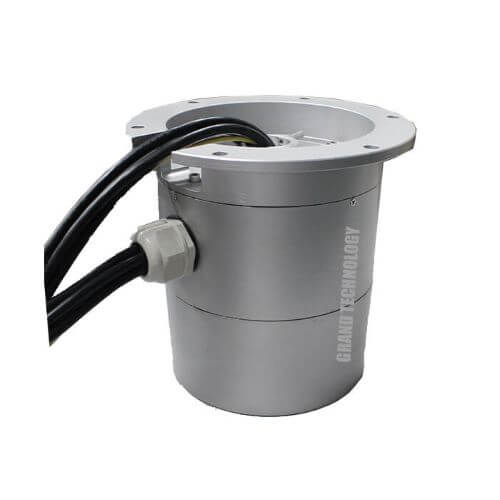
High Voltage/High Current Slip Ring are used for communication devices, large machining centers, antenna radar systems, large cranes, mining machines, and large cable reels. High voltage sometimes requires more than 2,000 volts and high current sometimes requires 500 amperes.
Model | ID(mm) | OD(mm) | No. of Rings | Max Rated Current | |
50 | 135 | 4 | 280A | ||
66 | 202 | 20 | 500A | ||
70 | 176 | 8 | 100A | ||
75 | 185 | 98 | 1000A | ||
75 | 190 | 4 | 400A | ||
80 | 180 | 3 | 250A |
Waterproof Slip Ring
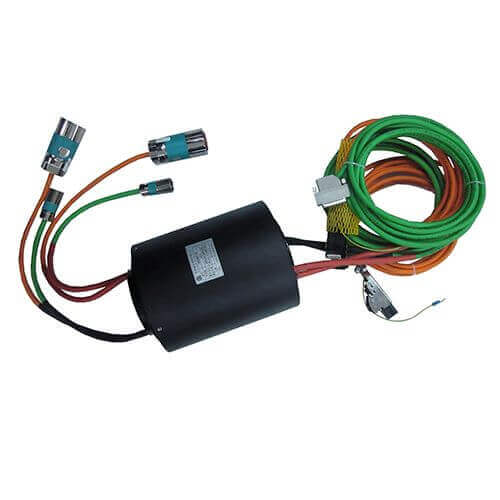
A waterproof slip ring is especially for working under moisture, corrosion, and underwater. The protection grade will be IP65, IP67, and IP68, and the liquid components in the working environment such as freshwater, seawater, oil should be considered. Waterproof slip rings are widely used in ships, harbor equipment, and some water or moisture environment working conditions. The units work well for transmitting precision signals, and electrical power.
CAN Bus Slip Ring
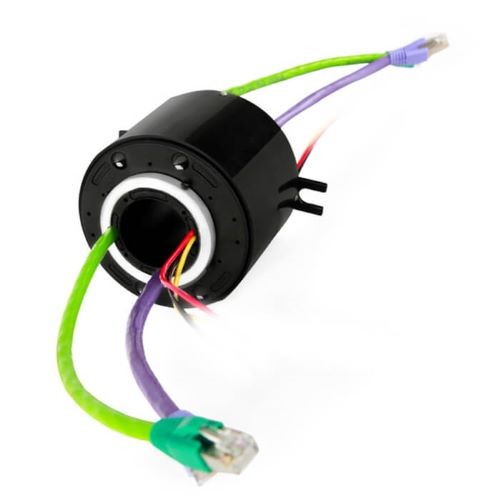
The industrial bus type mainly solves the digital communication between the field equipment such as intelligent instruments, controllers, and actuators in the industrial field, as well as the information transfer between these field control equipment and the advanced control system. The bus design will directly affect the performance, reliability, expansibility, and upgradability of the whole microcomputer system.
Servo Encoder Slip Ring
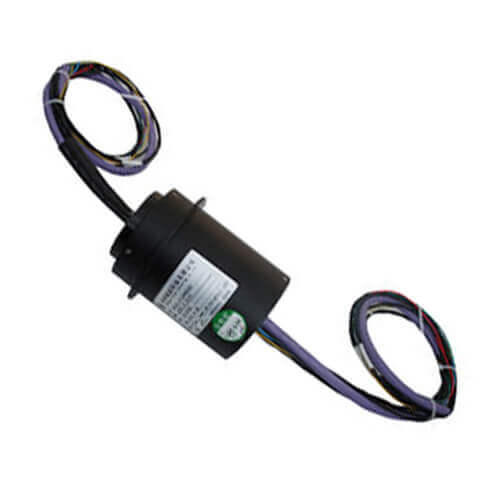
The servo encoder slip ring is an electrical slip ring that works for the servo encoder signal and servo motor power supply. The servo encoder slip ring can save many cables and installation works to transmit data and power. Suitable for all kinds of servo/stepper motors. Supplies usually use gold contacts to avoid external interference and internal interference.
PCB Slip Ring
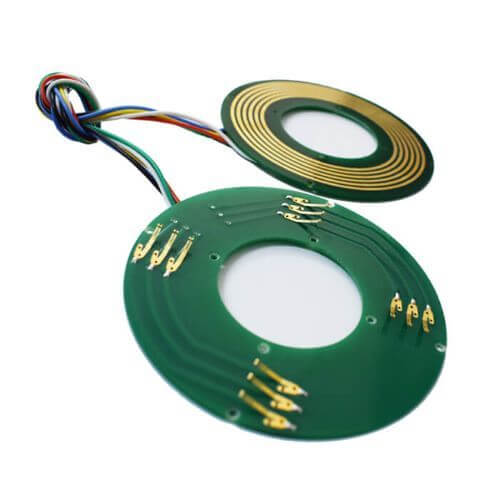
PCB slip ring is a kind of pancake slip ring, also called ultrathin flat slip ring. A common form of flat slip rings and made up of two parts, ring surface, and brush assembly. The ring surface circuit board with an ultra-thick copper layer, then copper plating, and hard gold plating, so the PCB slip rings have high hardness and wear resistance features.
Buying Tips about Slip Ring ID
Whether you’re a hobbyist working on a personal project or a professional involved in an industrial installation, buying the right slip ring requires careful consideration. The Slip Ring ID is a crucial factor to consider, playing a significant role in determining the slip ring’s suitability for your application. Here are some key tips to bear in mind when making your purchase:
Know Your Measurements
Before proceeding with any purchase, it is essential to know the measurements of the shaft or mounting structure of the slip ring that will be installed. Make sure the Slip Ring ID is slightly larger than this measurement to ensure a proper fit.
Understand the Operational Environment
Consider the operational environment – if the machine runs at high speeds or under high torque, you may need a slip ring with a larger ID. Similarly, if the slip ring will be used in a harsh or dirty environment, consider a sealed slip ring with a suitable ID.
Opt for High-Quality Materials
The material construction of the slip ring also affects its performance. High-quality materials offer better durability, resistance to wear, and offer excellent electrical conductivity. Make sure your chosen slip ring uses reliable, high-quality materials and is designed to handle the demands of your application.
Consider Long-term Performance
Do not sacrifice long-term performance for short-term savings. A slip ring with a slightly smaller ID might be cheaper, but it can lead to increased wear, higher maintenance costs, and a shorter system lifespan. Always balance the upfront cost against potential future expenditures.
Seek Professional Advice
When in doubt, always seek professional advice. Reputable manufacturers and retailers typically offer guidance and assistance in selecting the most suitable slip ring for your application. They can provide invaluable insights into what Slip Ring ID would be the best fit for your device or system based on its specific requirements.
By keeping these tips in mind, you can ensure that you select a slip ring with an appropriate ID, which offers the best possible performance for your system and delivers value for money in the long term.
Conclusion
The value of Slip Ring ID is highlighted across our extensive exploration covering its various applications, from intricate miniature devices, and robust electric motors, to large-scale wind turbines, and stringent aerospace applications. It’s not just a component, but a significant factor that determines the system’s efficacy, performance, and durability. Improper selection of Slip Ring ID can lead to complications such as unsmooth rotation, friction-induced heating, intermittent electrical contact, and more, negatively impacting the longevity of both the slip ring and the system it serves.
When purchasing a slip ring, multiple considerations come into play, including understanding the operational environment, long-term performance expectations, and superior-quality materials used in construction. A well-informed purchase can optimize your system’s efficiency and longevity, and this understanding underlines the importance of knowledgeable decision-making in maximizing operational efficiency and system reliability. To sum it up, the care invested in understanding and selecting the appropriate Slip Ring ID ensures not only the functionality of our equipment but also its durability and reliability, practically shaping the future of our rotating systems.
FAQ About Slip Ring ID
Q: Can I use a slip ring with a larger ID for my shaft with a smaller diameter?
A: While a larger ID won’t hinder the rotation, it might lead to instability if the difference is substantial. It’s always best to have an ID closely matching the shaft or mount diameter.
Q: What should I do if my Slip Ring rotation is unsmooth?
A: An unsmooth rotation can often be the result of an imperfectly chosen Slip Ring ID. Check if your ID is either too tight or loose, and find a replacement that perfectly fits your needs.
Q: How much bigger should a Slip Ring ID be than my shaft’s diameter?
A: Ideally, there should be a close match between the shaft diameter and the Slip Ring ID. However, a small tolerance for a slip ring ID being larger than the shaft diameter is acceptable for ensuring smooth rotation.
In conclusion, a thorough understanding of Slip Ring ID can significantly contribute to a smooth and efficient operational experience in any rotating system. This seemingly minor component becomes the heart of the machine when its significance is truly recognized.
See What We Can Do

